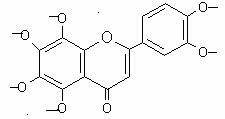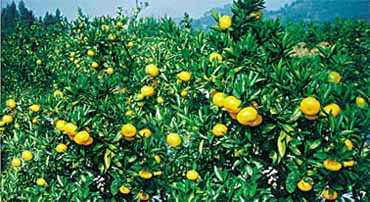Poly-Methoxylated Flavones (PMFs)
What is the PMFs ?
A joint study by the US Department of Agriculture and KGK Synergize, a Canadian nutraceutical company, identified a class of compounds isolated from orange and tangerine peels that shows promise in animal studies as a potent, natural alternative for lowering LDL cholesterol (so-called ‘bad' cholesterol), without the possible side effects, such as liver disease and muscle weakness, of conventional cholesterol-lowering drugs.
The findings, released in the Journal of Agricultural and Food Chemistry, a peer-reviewed publication of the American Chemical Society, the world's largest scientific society, show that the compounds, called polymethoxylated flavones (PMFs), are similar to other plant pigments found in citrus fruits that have been increasingly linked to health benefits, including protection against cancer, heart disease and inflammation.
The main polymethoxylated flavones (PMFs) exist in citrus are Tangeretin,Nobiletin and Sinesitin.
Identification of main PMFs
Ingredient |
Tangeretin |
Structure:
 |
Synonyms |
5,6,7,8-Tetramethoxy-2-(4-methoxyphenyl)-4-benzopyrone |
Molecular Formula |
C20H20O7 |
Molecular Weight |
372.37 |
CAS no. |
481-53-8 |
EINECS |
207-570-1 |
Ingredient |
Nobiletin |
Structure:
 |
Synonyms |
3',4',5,6,7,8-hexamethoxyflavone |
Molecular Formula |
C21H22O8 |
Molecular Weight |
402.39 |
CAS no. |
478-01-3 |
EINECS |
|
Ingredient |
Sinensetin |
Structure:
 |
Synonyms |
3’,4’,5,6,7-pentamethoxyflavone |
Molecular Formula |
C20H20O7 |
Molecular Weight |
372.39 |
CAS no. |
2306-27-6 |
EINECS |
|
Scientific support
The above joint study has shown that PMFs have the most potent cholesterol-lowering effect of any other citrus flavonoids and also PMFs have the potential to rival and even beat the cholesterol-lowering effect of some prescription drugs, without the risk of side effects.
Using hamster models with diet-induced high cholesterol, the researchers showed that feeding them food containing 1 per cent PMFs lowered levels of LDL cholesterol by 32 to 40 per cent.
Previous animal studies by others have shown that similar flavonoids, particularly hesperidin from oranges and naringin from grapefruit, also may have the ability to lower cholesterol, although not as effectively as PMFs.
Treatment with PMFs did not appear to have any effect on levels of HDL cholesterol, or good cholesterol,No negative side effects were seen in the animals that were fed the compounds,
The researchers are currently exploring the compound's mechanism of action on cholesterol metabolism. They now suspect, based on early results in cell and animal studies, that it works by inhibiting the synthesis of cholesterol and triglycerides inside the liver.
A long-term human study of the effect of PMFs on high LDL cholesterol is now in progress. While drinking citrus fruits is full of health benefits, taking PMF supplements could be an easier way to lower cholesterol, since a person would have to drink 20 or more cups a day of orange or tangerine juice to have a therapeutic effect.
Application
KGK Synergize already has developed a nutrition supplement containing PMFs combined with a form of vitamin E that seems to enhance the compound's effect, according to Kurowska. Marketed as a cholesterol-lowering agent under the trade name Sytrinol, the supplement recently became available in the US.
Distribution
PMFs are found in a variety of citrus fruits. The most common citrus PMFs, tangeretin and nobiletin, are found in the peels of tangerines and oranges. They are also found in smaller amounts in the juices of these fruits.
Availability
Commercial Polymethoxylated flavones are obtained by extraction from citrus peel,citrus oil and citrus fruit.

Citrus trees
Warning:
Above information is only knowledge,not an instruction of usage for this product. The owner of this webiste should not be responsible for any damage because of misuse of the product.
|



